After the morning game drive at Manyara national park, we proceeded towards the Serengeti National park which is about 200 kms and 4 hours of drive through the beautiful Ngorongoro caldera rim. Serengeti gets it’s name from the Masaii language word “seringitu” which means endless plains. The Serengeti plains are formed because of the volcanic ash strewn by the Ngorongoro volcano when it was active and are full of sulfurous salts, thus no dense forest here.
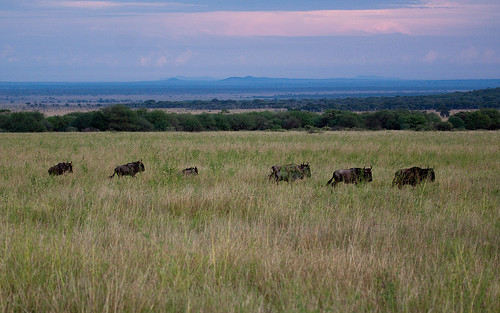
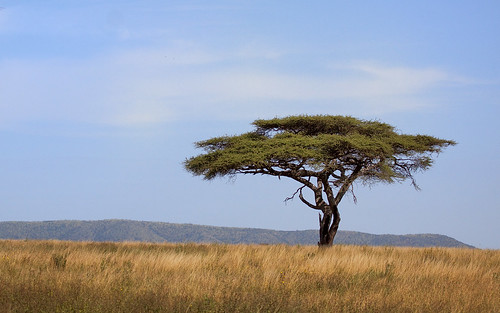
Rajai (our driver and guide) told us that before the Government of Tanzania declared Serengeti as a national park, it was home to two tribes; the Masaii, Datoga and *Hazabe Bushman tribe who were constantly clashing with each other over land and cattle. After the formation of the park, Masaii were given rights to live near the Serengeti while the Hazabe settled near Lake Eyasi. The Hazabe bushmen are hunters and eat the meat of wild animals (sometime even raw meat). The only animal they don’t eat is a Hyena as it is considered unclean. The Bushmen and speak the “click language” by clicking their tongue, teeth and palate**. The Datogas make ornament by melting iron, they are also adept in making spears and other hunting instrument which they sell to the Hazabe bushman in exchange of meat or money. Today under government protection while the numbers of Masaii are increasing, and they are even being schooled; the Hazabe bushman and Datoga are uneducated, culturally backward and their numbers are fast shrinking perhaps also due to genetic defects because of inbreeding which is very common, often within families too.
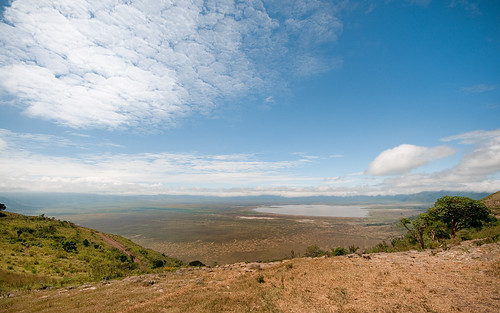
While Rajai was briefing us of the local Masaii culture, we couldn’t take eyes off the scenic beauty of the Ngorongoro Caldera rim which we had to cross to reach the Serengeti plains. The caldera rim at it’s highest was 2400 meters above sea level and the entirely covered with clouds. As we descended, we went by the 48 km long oldupai (also called as olduvai) gorge***. The fossiliferous gorge is named after the Olduvai plant, Sansevieria ehrenbergii, used by the Masaii as an antiseptic as a natural bandage and for stomach ailments. They also use it to make ropes, baskets, roofs and carpets. An Agave family plant, it is also a favourite food of Baboons, elephants, etc for it’s water content.
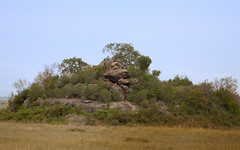
The moment we stepped into the Serengeti national park, we were taken aback by the sheer expanse of the land. Underlain by the volcanic rocks with branded ironstone (which is why so many rocks have red bands of oxidized iron), sedimentary quartz and sandstone, the Serengeti has several granite outcrops protruding from the plains (known as the Masaii Kopjes) which are home to many lion prides. The soil of Serengeti varies from coarse volcanic ash to fine and silty clay which gets water logged in the rains making it difficult to traverse.
One of the reasons we choose this time to visit the Serengeti was to witness the great migration and we were amply rewarded.
Millions of Wilder beasts and Zebras follow the annual migration from the dryer short grass plains of southern Serengeti towards the moister northern woodlands and Masai Mara plains.
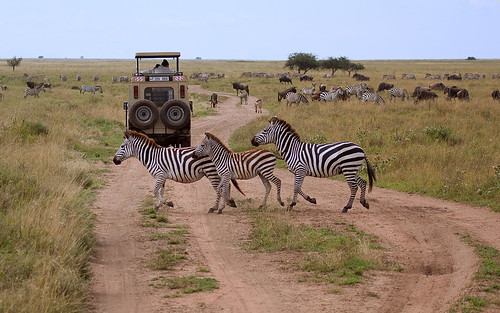
The wilder beasts give birth during February-March and by this time (May) the calves are big enough to take the long journey though we did see some very small calf in one of the herds. Wherever they are, the herds of wilder beasts and Zebra’s always attract predators and we were hoping to see at least one hunt, but were not lucky enough to witness it. We did see a lion pride feeding on a freshly killed Wilder beast though. The movement of herds is dependent on rainfall and we caught them in the north eastern region of Serengeti just before they crossed the Grumeti river. Pity we did not have time to witness them crossing the river full but we did see some small streams within Serengeti which witnessed the crossing just before we reached there. The evidence left behind was several dead Wilder-beasts being feasted on by the Vultures and storks.
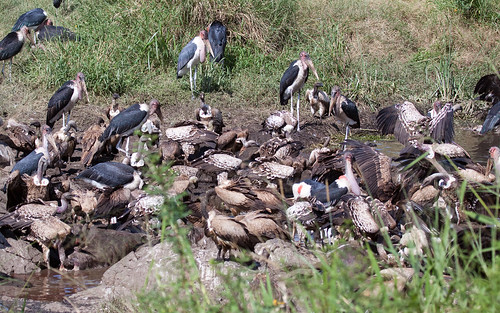
Much of north Serengeti is dominated by woodland and bushes such as Gerrard’s Acacia, Umbrella Acacia, and Whistling thorn and has a large population of animals like Giraffe, Impala, Elephants and Dikdik’s. The place is also plagued by a very irritating insect, the Tsetse fly. Thankfully this blood sucking fly is confined to very few belts of the north eastern Serengeti. Attempts to control the population of Tsetse fly by the park authority were very visible. Since the fly gets attracted black and blue colours, flags with these colours covered with insecticides were spotted all over the place, specially near the tents and lodges though these efforts by the park authorities did not prevent us from getting bitten hundreds of times. Aasim was worried that the one of us will catch Sleeping sickness, a disease caused by this fly. One of the naturalist however put his fears to rest when he told us that the Tsetsy fly of Serengeti does not carry the Sleeping sickness parasite.
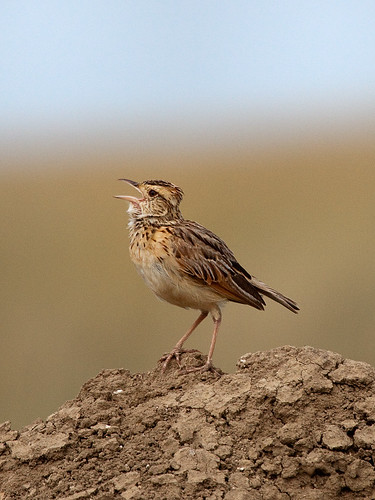
Serengeti bushlands and hillside are home to a wide variety of birds such as starlings, cisticolas, weavers, shrikes, mousebird, hornbills, kingfishers, barbets, sparrows and love birds. We were only too delighted to spot some of them and capture them in our camera. One of the most magnificent birds from this region is the Secretary bird Sagittarius sprpentarius. This graceful bird belongs to the order Falconiformes and is a bird of prey. It is monogamous and builds a platform nest on top of flat top tree canopies.
While we were busy looking at a a lion pride at the Masai Kopjes, a small mammal caught my attention. First I thought it was a small rabbit, but it wasn’t. It was a Rock Hyrax, the smallest relative of an elephant. The elephant and hyrax share some interesting traits, most notably being the arrangement of their toes. Four in front and three rear which are equipped with rounded hoof like nails. Like elephants, the hyrax have internal testes and have an extraordinarily long gestation period of around 7 months for an animal this small.

We spotted 4 out of the big 5 at the Serengeti. The Rhino eluded us. Lion ,Leopard, Elephants, Buffalo, both types of gazelles, impalas, baboons, hyenas, black backed fox, mongoose, dikdik, Harte beast … the list is endless. Just as we were to depart, we got the news that two Cheetahs are sitting almost on the road. However by the time we reached, they were far in grassland perhaps on a hunt. Their posture, the two of them standing together, taught, looking over a herd of impala’s is an image I would carry forever in my mind. Unfortunately my camera captured a very small, grainy image.
Many more high res photos of this memorable trip are on my flickr page
Information given by the guide substantiated by the following References:
*http://en.wikipedia.org/wiki/Hadza_people
** Click language video from Natgeo I found on youtube http://www.youtube.com/watch?v=c246fZ-7z1w
***http://en.wikipedia.org/wiki/Olduvai_Gorge
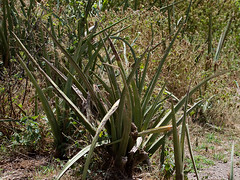
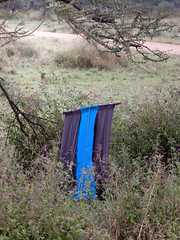
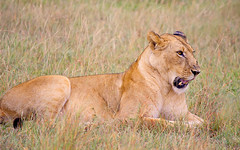
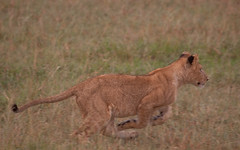
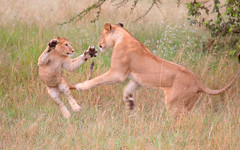
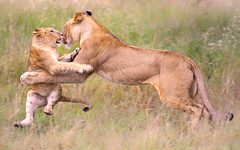
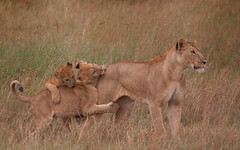
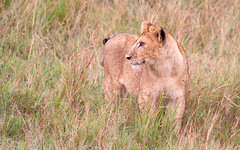
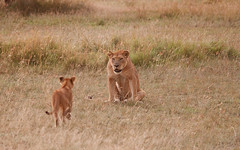
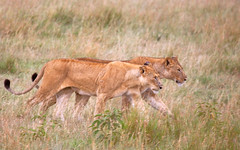
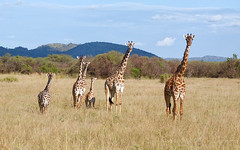
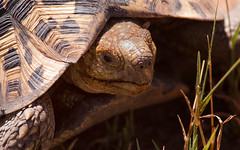
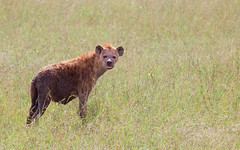
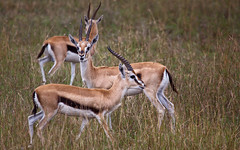
Hey Swati..thanks for posting this!I loved the pics of the majestic king and his pride!Besides the wonderful photos u shot..u seem to have made excellent research work on the place.I feel as though Discovery channel is on my desktop!Amazing piece of work there from you.Thanks once again for putting that on the blog for me 🙂
You are welcome, girl, and a very happy birthday to you again 🙂